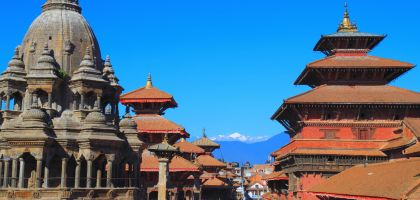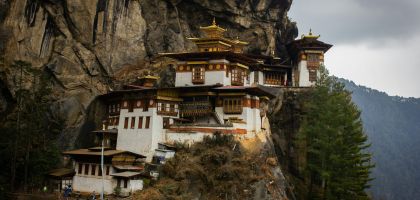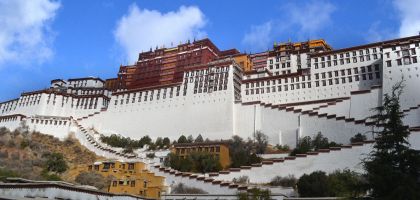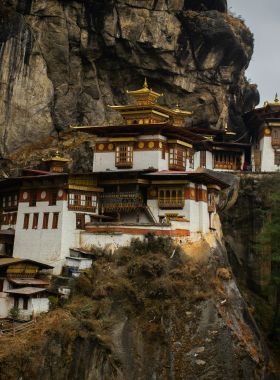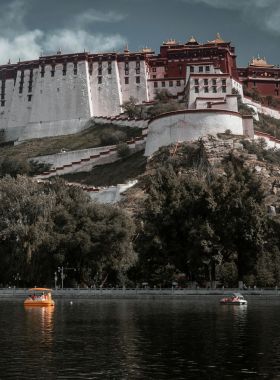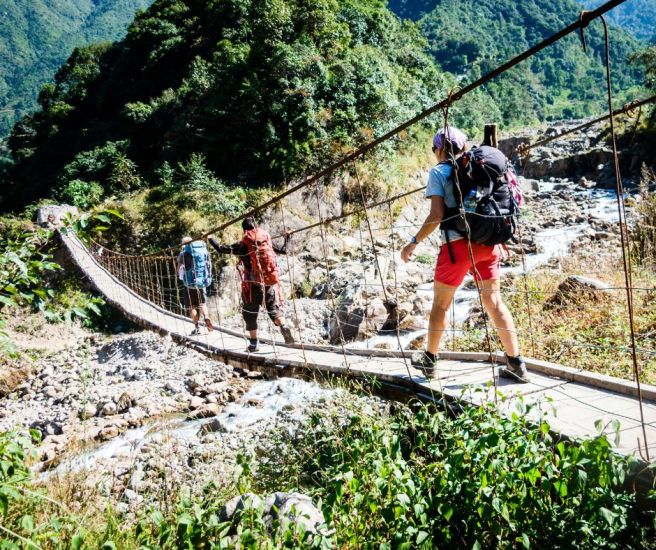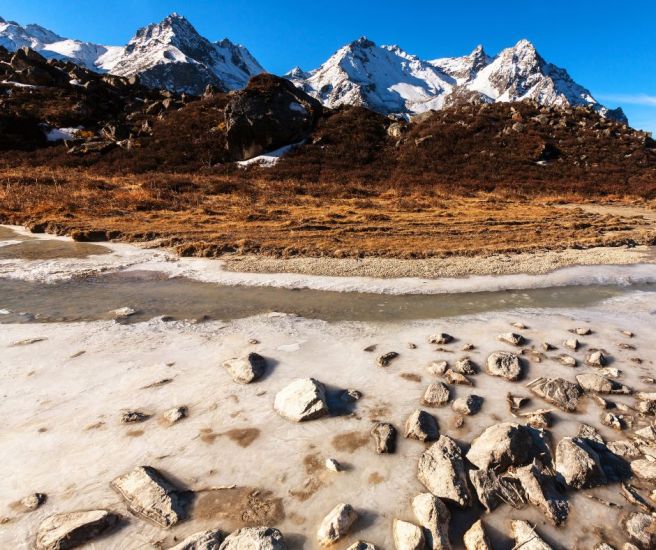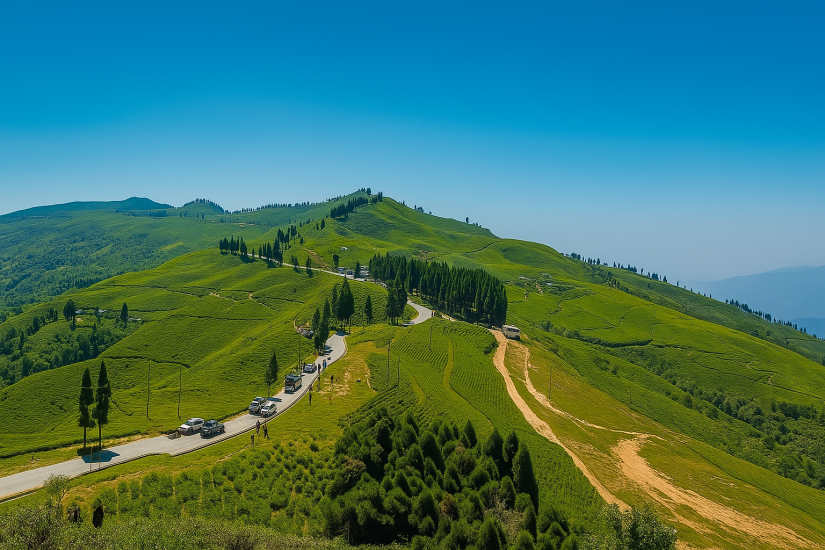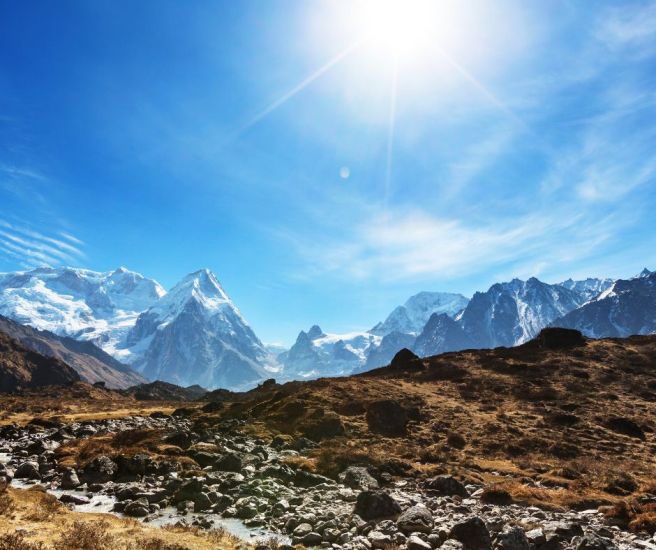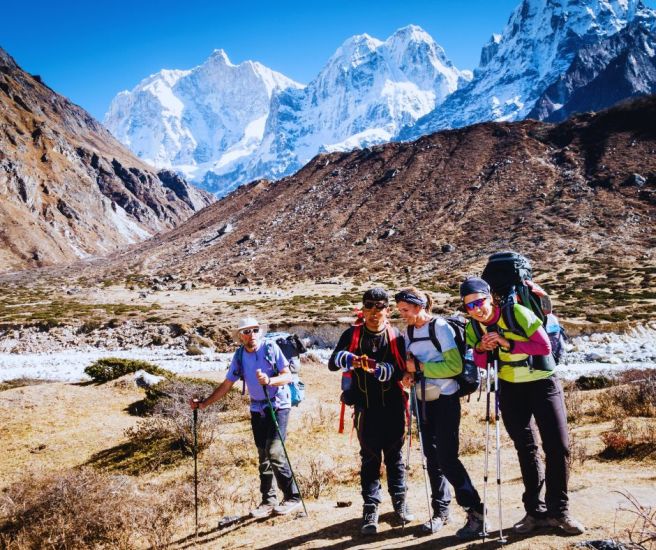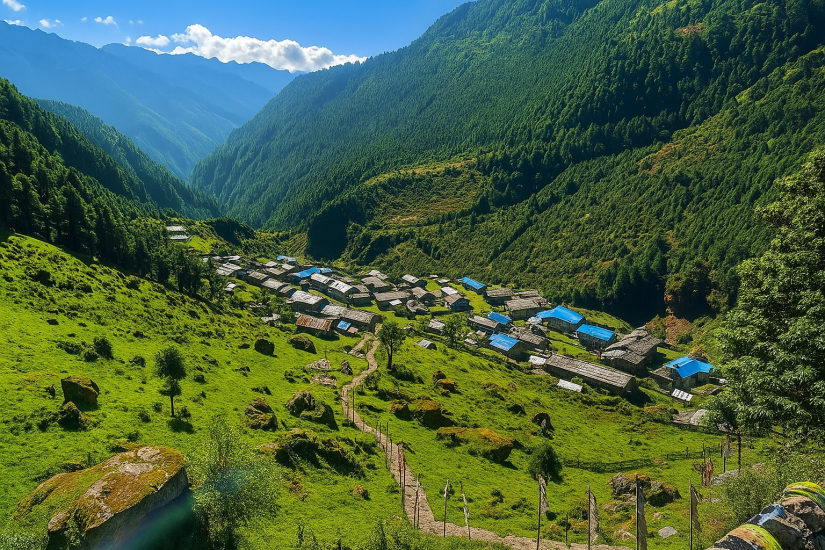Kanchenjunga Base Camp Trek
19 Days / Nepal
Activity
Difficulty Level
Destinations
Trip Start / End
Max Altitude
Accommodation
Travel Style
Best time to travel
Personalized Travel Advice

Dev Raj Nepal
+977 9851096523
Detailed Itinerary
01
DAY
01
Upon your arrival, you will be warmly welcomed at the airport and comfortably transferred to your hotel. Depending on your arrival time, you have the option to unwind and settle in at your hotel or venture out to explore the vibrant bazaars of Kathmandu. Wander through the lively streets, where the hustle and bustle of local markets offer a perfect introduction to the city’s rich culture and heritage.
Arrival in Kathmandu
Upon your arrival, you will be warmly welcomed at the airport and comfortably transferred to your hotel. Depending on your arrival time, you have the option to unwind and settle in at your hotel or venture out to explore the vibrant bazaars of Kathmandu. Wander through the lively streets, where the hustle and bustle of local markets offer a perfect introduction to the city’s rich culture and heritage.
02
DAY
02
Early in the morning, you will drive to Tribhuvan International Airport in Kathmandu to catch the first available domestic flight to Bhadrapur. This ensures ample time for the long road journey ahead. Upon arrival at Bhadrapur Airport, you will board a private vehicle for an 7 to 8-hour drive to Taplejung.
The drive takes you through the lush lowlands of eastern Nepal, passing through vibrant towns and terraced hillsides. As you ascend, the landscape transforms into rolling hills and deep river valleys. You’ll pass through Phidim, a bustling town and a perfect spot for a short break to stretch your legs and enjoy local snacks.
Continuing onward, the winding mountain roads offer breathtaking views of the surrounding hills and forests. The journey, though long, provides a glimpse into the rural life of eastern Nepal, with tea gardens and traditional villages along the way. By evening, you will arrive in Taplejung, a gateway to the Kanchenjunga region, where you will check into a local lodge for the night.
Fly to Bhadrapur & Drive to Taplejung
Early in the morning, you will drive to Tribhuvan International Airport in Kathmandu to catch the first available domestic flight to Bhadrapur. This ensures ample time for the long road journey ahead. Upon arrival at Bhadrapur Airport, you will board a private vehicle for an 7 to 8-hour drive to Taplejung.
The drive takes you through the lush lowlands of eastern Nepal, passing through vibrant towns and terraced hillsides. As you ascend, the landscape transforms into rolling hills and deep river valleys. You’ll pass through Phidim, a bustling town and a perfect spot for a short break to stretch your legs and enjoy local snacks.
Continuing onward, the winding mountain roads offer breathtaking views of the surrounding hills and forests. The journey, though long, provides a glimpse into the rural life of eastern Nepal, with tea gardens and traditional villages along the way. By evening, you will arrive in Taplejung, a gateway to the Kanchenjunga region, where you will check into a local lodge for the night.
03
DAY
03
Today, we take a scenic drive from Taplejung to Chiruwa, a journey that takes approximately 7 to 8 hours. The route winds through picturesque hills, terraced farmlands, and small mountain villages, offering glimpses of rural life in eastern Nepal. As we descend into the deep Himalayan gorge, the landscape transforms into lush subtropical rainforests, with towering cliffs and cascading waterfalls adding to the dramatic scenery.
Chiruwa, our destination for the night, is a small settlement nestled along the banks of the Tamor River. The area is home to the Kirati people, now known as the Limbu, one of the oldest ethnic groups in Nepal. Upon arrival, we set up camp and take in the tranquil atmosphere of this remote Himalayan village, surrounded by nature and rich cultural heritage.
Drive to Chiruwa
Today, we take a scenic drive from Taplejung to Chiruwa, a journey that takes approximately 7 to 8 hours. The route winds through picturesque hills, terraced farmlands, and small mountain villages, offering glimpses of rural life in eastern Nepal. As we descend into the deep Himalayan gorge, the landscape transforms into lush subtropical rainforests, with towering cliffs and cascading waterfalls adding to the dramatic scenery.
Chiruwa, our destination for the night, is a small settlement nestled along the banks of the Tamor River. The area is home to the Kirati people, now known as the Limbu, one of the oldest ethnic groups in Nepal. Upon arrival, we set up camp and take in the tranquil atmosphere of this remote Himalayan village, surrounded by nature and rich cultural heritage.
04
DAY
04
Today marks the beginning of our trek. The trail is well-defined, making the walk both enjoyable and rewarding. We start with gentle ascents, gradually entering the valley, where we begin to notice subtle changes in the landscape around us. The lush greenery, interspersed with rocky terrain, creates a stunning backdrop as we move forward.
As we trek, we navigate through large boulders, passing below the village of Tapethok. The trail then takes us across a landslide-prone section before we reach a bridge spanning a tributary of the Tamur River. This is the Simbuwa Khola, a glacial river originating from the southern slopes of Kanchenjunga.
From here, we press on towards the base camp route, crossing multiple bridges and following the course of the Gunsa Khola, which guides us deeper into the heart of the Himalayas. Overnight at a guesthouse in Sukethum.
Trek to Sukethum
Today marks the beginning of our trek. The trail is well-defined, making the walk both enjoyable and rewarding. We start with gentle ascents, gradually entering the valley, where we begin to notice subtle changes in the landscape around us. The lush greenery, interspersed with rocky terrain, creates a stunning backdrop as we move forward.
As we trek, we navigate through large boulders, passing below the village of Tapethok. The trail then takes us across a landslide-prone section before we reach a bridge spanning a tributary of the Tamur River. This is the Simbuwa Khola, a glacial river originating from the southern slopes of Kanchenjunga.
From here, we press on towards the base camp route, crossing multiple bridges and following the course of the Gunsa Khola, which guides us deeper into the heart of the Himalayas. Overnight at a guesthouse in Sukethum.
05
DAY
05
Following the winding path of the Ghunsa Khola, we trek towards Amjilosa, ascending through steep, rugged terrain that offers an exhilarating challenge. The landscape around us is nothing short of spectacular, with towering peaks, deep valleys, and the serene flow of the river accompanying our journey. Along the way, we cross several bridges that span the Ghunsa Khola, each offering a unique perspective of the river’s crystal-clear waters below.
As we climb higher, the scenery changes, with the air growing cooler and the terrain becoming more dramatic. After several hours of walking, we finally reach Amjilosa, a charming Tibetan village that sits nestled in the valley. The village, with its traditional stone houses and picturesque surroundings, offers a peaceful stop to rest and soak in the tranquil atmosphere. Overnight at a Guesthouse.
Trek to Amjilosa
Following the winding path of the Ghunsa Khola, we trek towards Amjilosa, ascending through steep, rugged terrain that offers an exhilarating challenge. The landscape around us is nothing short of spectacular, with towering peaks, deep valleys, and the serene flow of the river accompanying our journey. Along the way, we cross several bridges that span the Ghunsa Khola, each offering a unique perspective of the river’s crystal-clear waters below.
As we climb higher, the scenery changes, with the air growing cooler and the terrain becoming more dramatic. After several hours of walking, we finally reach Amjilosa, a charming Tibetan village that sits nestled in the valley. The village, with its traditional stone houses and picturesque surroundings, offers a peaceful stop to rest and soak in the tranquil atmosphere. Overnight at a Guesthouse.
06
DAY
06
Today’s trek takes us through a beautifully forested trail filled with rhododendrons and bamboo, creating a lush and vibrant atmosphere. As we move deeper into the Kanchenjunga region, the sounds of rustling leaves and chirping birds accompany our journey. If luck is on our side, we may even spot a rare Red Panda hidden among the dense foliage.
Along the way, we come across a spectacular waterfall cascading down the cliffs on the opposite side of the river, adding to the breathtaking scenery. The trail gradually ascends, and as we gain altitude, the landscape begins to change, revealing stunning mountain vistas and multiple smaller waterfalls tumbling down rocky slopes.
After a steady climb, we reach the picturesque village of Gyabla, a remote settlement surrounded by towering peaks and pristine nature. The final stretch involves a steep ascent followed by a descent before we finally arrive in Gyabla, where we settle in for the night.
Amjilosa to Gyabla
Today’s trek takes us through a beautifully forested trail filled with rhododendrons and bamboo, creating a lush and vibrant atmosphere. As we move deeper into the Kanchenjunga region, the sounds of rustling leaves and chirping birds accompany our journey. If luck is on our side, we may even spot a rare Red Panda hidden among the dense foliage.
Along the way, we come across a spectacular waterfall cascading down the cliffs on the opposite side of the river, adding to the breathtaking scenery. The trail gradually ascends, and as we gain altitude, the landscape begins to change, revealing stunning mountain vistas and multiple smaller waterfalls tumbling down rocky slopes.
After a steady climb, we reach the picturesque village of Gyabla, a remote settlement surrounded by towering peaks and pristine nature. The final stretch involves a steep ascent followed by a descent before we finally arrive in Gyabla, where we settle in for the night.
07
DAY
07
Our journey today takes us through enchanting woodlands teeming with diverse flora and fauna, making for a truly immersive trekking experience. As we walk beneath the canopy of rhododendrons, pines, and fir trees, we may encounter a variety of bird species and, with some luck, glimpses of Himalayan wildlife.
Following the forested trail, we arrive at Phale, a small Tibetan settlement where we can see prayer flags fluttering in the wind and traditional houses reflecting the region’s rich heritage. From here, we ascend a gentle hill before descending towards the river, where a bridge crossing brings us closer to our destination.
Soon, we reach Ghunsa, a beautiful Tibetan village characterized by its wooden houses, prayer wheels, and welcoming local community. The village is well-equipped with a micro-hydropower plant, a school, and a health post, offering essential services to the remote Himalayan inhabitants. Moving at a steady pace, we complete our trek for the day and settle into a cozy lodge, surrounded by the serenity of the mountains.
Gyabla to Ghunsa
Our journey today takes us through enchanting woodlands teeming with diverse flora and fauna, making for a truly immersive trekking experience. As we walk beneath the canopy of rhododendrons, pines, and fir trees, we may encounter a variety of bird species and, with some luck, glimpses of Himalayan wildlife.
Following the forested trail, we arrive at Phale, a small Tibetan settlement where we can see prayer flags fluttering in the wind and traditional houses reflecting the region’s rich heritage. From here, we ascend a gentle hill before descending towards the river, where a bridge crossing brings us closer to our destination.
Soon, we reach Ghunsa, a beautiful Tibetan village characterized by its wooden houses, prayer wheels, and welcoming local community. The village is well-equipped with a micro-hydropower plant, a school, and a health post, offering essential services to the remote Himalayan inhabitants. Moving at a steady pace, we complete our trek for the day and settle into a cozy lodge, surrounded by the serenity of the mountains.
08
DAY
08
Today is a well-deserved rest day, allowing us to recuperate after several days of trekking. If the weather is favorable, we can take the opportunity to wash some clothes, reorganize our gear, or simply relax and soak in the peaceful atmosphere of Ghunsa. This break gives our bodies time to adjust to the increasing altitude, making the upcoming trek more comfortable.
For those who wish to explore, there is an optional three-hour hike across the river to Khanso Thanso. This short excursion rewards us with breathtaking panoramic views of Phole Peak and Sobithongi Peak, along with a distant yet stunning glimpse of Mt. Khumbakarna (also known as Jannu). The surrounding landscapes, with their towering snow-capped summits and rugged beauty, make for an unforgettable sight.
After days of continuous trekking, taking a moment to rest and appreciate the grandeur of the Himalayas is highly recommended before we continue our journey deeper into the Kanchenjunga region.
Rest and acclimatization in Ghunsa
Today is a well-deserved rest day, allowing us to recuperate after several days of trekking. If the weather is favorable, we can take the opportunity to wash some clothes, reorganize our gear, or simply relax and soak in the peaceful atmosphere of Ghunsa. This break gives our bodies time to adjust to the increasing altitude, making the upcoming trek more comfortable.
For those who wish to explore, there is an optional three-hour hike across the river to Khanso Thanso. This short excursion rewards us with breathtaking panoramic views of Phole Peak and Sobithongi Peak, along with a distant yet stunning glimpse of Mt. Khumbakarna (also known as Jannu). The surrounding landscapes, with their towering snow-capped summits and rugged beauty, make for an unforgettable sight.
After days of continuous trekking, taking a moment to rest and appreciate the grandeur of the Himalayas is highly recommended before we continue our journey deeper into the Kanchenjunga region.
09
DAY
09
Today, we continue our trek along a forested path, following the south bank of the Ghunsa Khola. The trail is adorned with Mani walls and Chortens, reflecting the deep Buddhist heritage of the region. As we walk, the soothing sound of the river accompanies us, adding to the serene atmosphere of the journey.
Further along, we navigate through scree slopes and glacial moraines, where the rugged terrain reminds us of the raw, untamed beauty of the Himalayas. With every step, the landscape becomes more dramatic, and as we approach the Tibetan settlement of Khangpachen, we are rewarded with a breathtaking view of the north face of Jannu (7,710m), a towering peak revered by locals as “The Wall of Shadows.”
Arriving in Khambachen, we settle into our lodge, taking in the awe-inspiring surroundings and preparing for the next leg of our adventure.
Trek to Khambachen
Today, we continue our trek along a forested path, following the south bank of the Ghunsa Khola. The trail is adorned with Mani walls and Chortens, reflecting the deep Buddhist heritage of the region. As we walk, the soothing sound of the river accompanies us, adding to the serene atmosphere of the journey.
Further along, we navigate through scree slopes and glacial moraines, where the rugged terrain reminds us of the raw, untamed beauty of the Himalayas. With every step, the landscape becomes more dramatic, and as we approach the Tibetan settlement of Khangpachen, we are rewarded with a breathtaking view of the north face of Jannu (7,710m), a towering peak revered by locals as “The Wall of Shadows.”
Arriving in Khambachen, we settle into our lodge, taking in the awe-inspiring surroundings and preparing for the next leg of our adventure.
10
DAY
10
Today, our journey continues along the path leading to the Kanchenjunga glacier. During peak trekking season, we’ll encounter fellow trekkers making their way to and from the Kanchenjunga North Base Camp. As we trek through Ramdang, we come upon the serene Ramdang Monastery. The trail ahead becomes more challenging as we approach the junction of the Lhonak and Kanchenjunga glaciers. Pressing on, we eventually arrive at the small settlement of Lhonak, where a few guesthouses offer rest and refuge.
Trek to Lhonak
Today, our journey continues along the path leading to the Kanchenjunga glacier. During peak trekking season, we’ll encounter fellow trekkers making their way to and from the Kanchenjunga North Base Camp. As we trek through Ramdang, we come upon the serene Ramdang Monastery. The trail ahead becomes more challenging as we approach the junction of the Lhonak and Kanchenjunga glaciers. Pressing on, we eventually arrive at the small settlement of Lhonak, where a few guesthouses offer rest and refuge.
11
DAY
11
Today, we take a well-deserved break in Lhonak, allowing our bodies to adjust to the higher altitude. It’s a perfect opportunity to relax, explore the small settlement, and enjoy the breathtaking views surrounding us. This rest day ensures we’re ready for the challenging days ahead.
Rest and acclimatization in Lhonak
Today, we take a well-deserved break in Lhonak, allowing our bodies to adjust to the higher altitude. It’s a perfect opportunity to relax, explore the small settlement, and enjoy the breathtaking views surrounding us. This rest day ensures we’re ready for the challenging days ahead.
12
DAY
12
Exploring the upper end of the valley is a must to truly appreciate the grandeur of the peaks that form one of the largest mountain masses in the world. The majestic Kanchenjunga and Wedge Peak remain hidden until we approach Pang Pema (5140m). To maximize our chances of witnessing stunning mountain views, we plan to spend the night here, although this depends on weather conditions, trail status, and each group member’s progress, as assessed by your guide. The trail often follows moraine, which can be challenging due to its changing nature and infrequent use. Several nearby side trails offer spectacular panoramas, including views of the Pyramid Peaks, as well as the Twins. Fortunately, impressive mountain views can be found without venturing too far. We will aim to spend as much time as possible in this area, hoping for favorable weather conditions.
We return to Lhonak in the afternoon. Overnight at Lhonak.
To Kanchenjunga North Base Camp (Pang pema) – Return to Lhonak
Exploring the upper end of the valley is a must to truly appreciate the grandeur of the peaks that form one of the largest mountain masses in the world. The majestic Kanchenjunga and Wedge Peak remain hidden until we approach Pang Pema (5140m). To maximize our chances of witnessing stunning mountain views, we plan to spend the night here, although this depends on weather conditions, trail status, and each group member’s progress, as assessed by your guide. The trail often follows moraine, which can be challenging due to its changing nature and infrequent use. Several nearby side trails offer spectacular panoramas, including views of the Pyramid Peaks, as well as the Twins. Fortunately, impressive mountain views can be found without venturing too far. We will aim to spend as much time as possible in this area, hoping for favorable weather conditions.
We return to Lhonak in the afternoon. Overnight at Lhonak.
13
DAY
13
After an unforgettable time at the Kanchenjunga North Base Camp, you’ll retrace your steps back to Ghunsa village. The trek, which passes through Khambachen, treats you to stunning views of towering peaks and pristine alpine landscapes. Following the quiet trail through Khambachen, you’ll once again be immersed in rhododendron forests and dramatic mountain scenery. Once in Ghunsa, you can recharge—literally and figuratively—with amenities like electronic charging, a hot shower, and a warmer, more comfortable room than those found higher up.
Lhonak to Ghunsa
After an unforgettable time at the Kanchenjunga North Base Camp, you’ll retrace your steps back to Ghunsa village. The trek, which passes through Khambachen, treats you to stunning views of towering peaks and pristine alpine landscapes. Following the quiet trail through Khambachen, you’ll once again be immersed in rhododendron forests and dramatic mountain scenery. Once in Ghunsa, you can recharge—literally and figuratively—with amenities like electronic charging, a hot shower, and a warmer, more comfortable room than those found higher up.
14
DAY
14
Today, we will retrace our steps back to Ghunsa and after crossing the Ghunsa Khola, it starts to head down in the valley following the same river to Phale. This village is full of Tibetan immigrants. (Around 6 hours stay at Tea house.
Ghunsa to Gyabla
Today, we will retrace our steps back to Ghunsa and after crossing the Ghunsa Khola, it starts to head down in the valley following the same river to Phale. This village is full of Tibetan immigrants. (Around 6 hours stay at Tea house.
15
DAY
15
Trek back to Amjilosa, where the path begins with a steep descent through lush bamboo forests. Along the way, you’ll cross several charming streams, their crystal-clear waters winding through the forest. As you make your way downhill, the landscape gradually transitions from remote wilderness toward more inhabited areas, signaling your return to civilization. The trek takes approximately 6 hours, offering plenty of time to take in the changing scenery. At the end of your day, you’ll find rest and comfort at a welcoming tea house, where you can relax after the journey.
Gyabla to Amjilosa
Trek back to Amjilosa, where the path begins with a steep descent through lush bamboo forests. Along the way, you’ll cross several charming streams, their crystal-clear waters winding through the forest. As you make your way downhill, the landscape gradually transitions from remote wilderness toward more inhabited areas, signaling your return to civilization. The trek takes approximately 6 hours, offering plenty of time to take in the changing scenery. At the end of your day, you’ll find rest and comfort at a welcoming tea house, where you can relax after the journey.
16
DAY
16
After leaving Amjilosa, the trail follows the river, with some challenging, steep sections along the way. As you descend, you’ll pass through increasingly frequent small settlements, eventually reaching the villages of Sekathum and Ranipul. From there, you’ll take a private jeep for a 4-hour drive to Taplejung. Upon arrival, check in at your hotel and enjoy an overnight stay in Taplejung.
Trek to Ranipul & Drive to Taplejung
After leaving Amjilosa, the trail follows the river, with some challenging, steep sections along the way. As you descend, you’ll pass through increasingly frequent small settlements, eventually reaching the villages of Sekathum and Ranipul. From there, you’ll take a private jeep for a 4-hour drive to Taplejung. Upon arrival, check in at your hotel and enjoy an overnight stay in Taplejung.
17
DAY
17
Today, you’ll travel from Taplejung to the serene Kanyam Tea Garden. The journey takes you through scenic landscapes, with lush greenery and rolling hills leading to one of Nepal’s most famous tea-growing regions. As you arrive, take in the breathtaking views of the tea estates and enjoy a peaceful retreat amidst the vibrant fields. The day offers a perfect opportunity to explore the gardens, learn about tea cultivation, and savor the fresh, aromatic tea.
Taplejung to Kanyam Tea Garden
Today, you’ll travel from Taplejung to the serene Kanyam Tea Garden. The journey takes you through scenic landscapes, with lush greenery and rolling hills leading to one of Nepal’s most famous tea-growing regions. As you arrive, take in the breathtaking views of the tea estates and enjoy a peaceful retreat amidst the vibrant fields. The day offers a perfect opportunity to explore the gardens, learn about tea cultivation, and savor the fresh, aromatic tea.
18
DAY
18
After breakfast, you’ll embark on a scenic drive to Bhadrapur. The journey offers beautiful views as you make your way through the countryside. Once in Bhadrapur, you’ll catch a flight back to Kathmandu. After landing, you’ll have the rest of the day to relax or explore the vibrant city at your leisure.
Drive to Bhadrapur – Fly to Kathmandu
After breakfast, you’ll embark on a scenic drive to Bhadrapur. The journey offers beautiful views as you make your way through the countryside. Once in Bhadrapur, you’ll catch a flight back to Kathmandu. After landing, you’ll have the rest of the day to relax or explore the vibrant city at your leisure.
19
DAY
19
Today, after breakfast, you will be transferred to the airport for Departure.
Departure
Today, after breakfast, you will be transferred to the airport for Departure.
Includes / Excludes
Inclusions
-
All transportation vehicles
-
Sightseeing in Kathmandu
-
Accommodations on a twin sharing basis
-
Domestic flights – Kathmandu – Bhadrapur – Kathmandu
-
Meals mentioned in the itinerary
-
Kanchenjunga restricted area entry permits
-
Kanchenjunga conservation entry permits
-
TIMS Card.
-
Experienced trekking guide
-
Porter (1 porter for 2 clients)
-
Government taxes and service charges.
Exclusions
-
Nepal entry visa Fee.
-
Entrance fee for heritage sites in Kathmandu
-
Personal Travel insurance.
-
Lunch and dinner in Kathmandu before and after the trek.
-
Beverages
-
Telephone, Landry, personal tips for driver, guide, and porter.
Trip Info
The best time to do the Kanchenjunga Base Camp Trek is during the spring (March to May) and autumn (September to November) seasons.
Spring (March to May): The weather is mild, with daytime temperatures ranging from 10°C to 15°C at lower altitudes and dropping to -5°C to 0°C at higher altitudes, especially around the base camp. This season offers clear skies and blooming rhododendron forests, making it a perfect time to enjoy the stunning mountain views.
Autumn (September to November): The skies are crisp and clear with daytime temperatures between 12°C and 18°C at lower altitudes, and -5°C to 5°C at higher elevations. This is the peak trekking season in Nepal, providing ideal conditions for trekking with pleasant temperatures and incredible views of Kanchenjunga and surrounding peaks.
Clothing & Footwear
- Waterproof and breathable jacket and pants
- Insulating layers (fleece, down jacket)
- Thermal base layers
- Hiking pants and shorts
- Warm hat and sun hat
- Gloves
- Warm socks
- Sturdy, waterproof hiking boots
- Comfortable sandals or shoes
Gear & Accessories
- Backpack (50-70 liters)
- Sleeping bag (rated for cold temperatures)
- Trekking poles
- Headlamp with extra batteries
- Sunglasses
- Sunscreen and lip balm
- Water bottles or hydration system
- Water purification tablets or filter
- Toiletries
- Quick-dry towel
Remember to pack light and efficiently.
Food on this Trek offers a delightful mix of traditional Nepali and Tibetan cuisine, providing trekkers with local flavors and ingredients. Dal Bhat, a hearty and nutritious meal consisting of rice, lentil soup, and vegetables, is a staple in Nepali trekking cuisine and is often served multiple times a day. It’s usually accompanied by a side of pickle for extra flavor. Momo, steamed or fried dumplings filled with meat or vegetables, are a popular snack or lunch option along the trail. For breakfast, Tibetan bread, a type of flatbread served with butter or jam, is commonly enjoyed, providing energy for the day ahead. Warm soups, such as vegetable soup, noodle soup, or thukpa (a Tibetan noodle soup), are common, offering comfort and warmth, especially in the colder regions. Most restaurants also offer Nepali Ramen, such as, Waiwai which is a flavorful comfort good.
Accommodations on the Kanchenjunga Base Camp Trek offer a blend of comfort and simplicity. In Kathmandu, you’ll enjoy a stay at a well-appointed hotel, offering modern amenities, comfortable rooms, and a relaxing atmosphere before the trek.
As you begin the trek, accommodations primarily consist of guesthouses and tea houses, which provide basic but cozy rooms with simple bedding. At higher altitudes, the lodges become more rustic, with shared rooms and minimal facilities. Expect shared bathrooms and limited hot water, but the warm hospitality of the locals will make your stay feel welcoming. Meals are usually served at the tea houses, offering a variety of local and international dishes to fuel your trek. The focus is on comfort and practicality, with the essentials provided for a memorable trekking experience.
Breathtaking Scenery and Majestic Peaks
Trekking in Nepal offers unparalleled views, and the Kanchenjunga Base Camp Trek is no exception. As you journey through lush forests, alpine meadows, and rugged trails, the towering snow-capped peaks of Kanchenjunga will dominate your horizon. The trek provides mesmerizing vistas of other Himalayan giants like Makalu and Everest in the distance. The pristine natural beauty and diverse landscapes—from dense rhododendron forests to alpine tundra—make this trek one of the most scenic in Nepal.
Challenging and Rewarding Terrain
The Kanchenjunga Base Camp Trek is known for its challenging terrain. The trek takes you through steep ascents, rocky paths, and narrow ridges, testing both your endurance and mental strength. As you gain altitude, the air grows thinner, making the trek physically demanding. It’s essential to take it slow and acclimatize at each stop to prevent altitude sickness. However, the difficulty of the trail is balanced by the extraordinary sense of accomplishment you’ll feel when reaching base camp. With each step, the stunning views of the Himalayas grow ever more rewarding.
Cultural Encounters and Local Hospitality
The trek offers an incredible opportunity to immerse yourself in the cultures of the Rai, Limbu, and Sherpa communities, who have lived in these mountains for centuries. You’ll pass through charming villages, where you can interact with locals, learn about their traditions, and experience their warm hospitality. Nepalese culture, deeply connected to the land and mountains, is on full display in these remote regions. The vibrant culture and the chance to witness life in the mountains adds a rich layer to your trekking experience.
Physical and Mental Challenge
Trekking to Kanchenjunga Base Camp requires a high level of physical fitness. The trek is strenuous, with long days of walking on uneven terrain and at high altitudes. The altitude can make the trek feel more challenging as you ascend, and proper acclimatization is essential for avoiding altitude sickness. The trek tests both your physical stamina and mental strength, but the rewards—both in terms of natural beauty and the satisfaction of completing the trek—are well worth the effort.
FAQs
Personalized Travel Advice

Dev Raj Nepal
+977 9851096523
